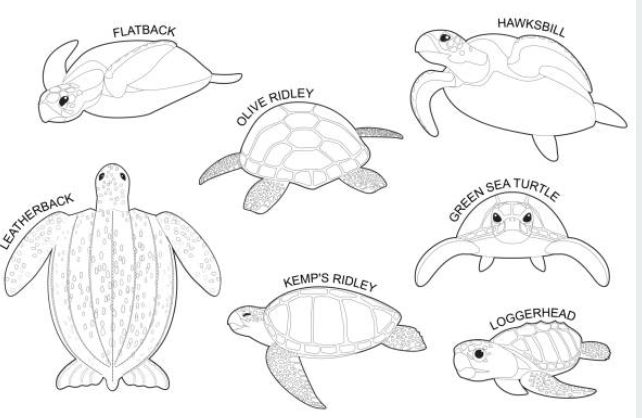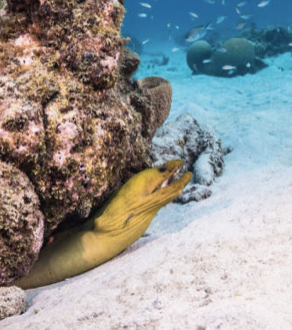Seasons and Sea Turtles
After leaving the Beyond the Sound (Open Ocean exhibit) guests will walk down a ramp with four small tanks on their right side. Each tank represents a different season in Long Island Sound. The species in these tanks can change frequently. Below is some basic information about seasonal changes to Long Island Sound.
Summer - Time to Grow
In the summer, the Sound has the greatest diversity. Warm water and abundant food lures all kinds of fish, birds, and turtles. Young hatch and grow quickly. It's not unusual to see bright Caribbean fish during the summer in the Long Island Sound.
Average water temperature is 60-75F
Fall - Cooler Days Ahead
Fall is a transitional time. As temperatures cool, the bluefish and striped bass that migrated into the Sound in the spring return to the open Atlantic and head south. Warm-water fish that earlier rode into the sound amidst the rafts of sargassum weed now must mirgrate or or will die.
Average water temperature is 52-67F
Winter - Chilly Waters
While some people in Connecticut travel south for the winter to escape the cold, some cold-climate sea animals travel here. Animals like seals, cod, wolffish, and winter flounder are frequent winter residents.
Average water temperature is 32-42F
Spring - A time for Change
As the hours of daylight increases and waters being to warm, winter species like cod, red hake and seals leave. Alewives, river herring, American shad and Atlantic sturgeon being their journey upstream to spawn.
Average water temperature is 40-60F
Sea Turtle Exhibit:

Sea turtles are large, air-breathing reptiles that inhabit tropical and subtropical seas throughout the world. Their shells consist of an upper part (carapace) and a lower section (plastron). Hard scales (or scutes) cover all but the leatherback, and the number and arrangement of these scutes can be used to determine the species.
Sea turtles come in many different sizes, shapes and colors. The olive ridley is usually less than 100 pounds, while the leatherback typically ranges from 650 to 1,300 pounds! The upper shell, or carapace, of each sea turtle species ranges in length, color, shape and arrangement of scales.
Sea turtles do not have teeth, but their jaws have modified “beaks” suited to their particular diet. They do not have visible ears but have eardrums covered by skin. They hear best at low frequencies, and their sense of smell is excellent. Their vision underwater is good, but they are nearsighted out of water. Their streamlined bodies and large flippers make them remarkably adapted to life at sea. However, sea turtles maintain close ties to land.
Reproduction:
Females must come ashore to lay their eggs in the sand; therefore, all sea turtles begin their lives as tiny hatchlings on land. Research on marine turtles has uncovered many facts about these ancient creatures. Most of this research has been focused on nesting females and hatchlings emerging from the nest, largely because they are the easiest to find and study.
Thousands of sea turtles around the world have been tagged to help collect information about their growth rates, reproductive cycles and migration routes. After decades of studying sea turtles, much has been learned. However, many mysteries still remain.
Growth & Development:
Only females come ashore to nest; males rarely return to land after crawling into the sea as hatchlings. Most females return to nest on the beach where they were born (natal beach). Nesting seasons occur at different times around the world. In the U.S., nesting occurs from April through October. Most females nest at least twice during each mating season; some may nest up to ten times in a season. A female will not nest in consecutive years, typically skipping one or two years before returning.
Researchers do not yet know how long baby turtles spend in the open sea, or exactly where they go. It is theorized that they spend their earliest, most vulnerable years floating around the sea in giant beds of sargassum weeds, where they do little more than eat and grow. Once turtles reach dinner-plate size, they appear at feeding grounds in nearshore waters. They grow slowly and take between 15 and 50 years to reach reproductive maturity, depending on the species. There is no way to determine the age of a sea turtle from its physical appearance. It is theorized that some species can live over 100 years.
Loggerhead Sea Turtle (Caretta caretta)

Description: Head is very large with heavy strong jaws. Carapace is bony without ridges and has large, non-overlapping, rough scutes (scales) present with 5 lateral scute. Carapace is heart shaped. Front flippers are short and thick with 2 claws, while the rear flippers can have 2 or 3 claws. Carapace is a reddish-brown with a yellowish-brown plastron. Hatchlings have a dark-brown carapace with flippers pale brown on margins.
Weight: Between 175 and 350 pounds. Average weight = 300 pounds
Carapace Length: Typically 2.5 to 3.5 feet in carapace length (80 to 110 cm)
Diet: Primarily shellfish including clams and mussels. Also eat horseshoe crabs and other invertebrates. At the Aquarium the Loggerhead receives 4lb of fish and squid per day.
Natural Range & Habitat: The loggerhead has the widest range of any of the sea turtles. It can be found in the Atlantic, Pacific and Indian oceans as well as the Mediterranean Sea. They prefer to feed in shallow coastal waters along the continental shelves.
Reproduction/Nesting: Maturity reached at 17 - 33 years of age. Loggerheads nest at intervals of 2 to 4 years, laying 3 to 6 nests per season, approx. 2 weeks apart. Average lay is 100 - 125 eggs with a 60 day incubation period.
Conservation Status: United States - Threatened, International - Vulnerable
Threats: Loss of nesting habitat due to coastal development, human disturbances and nest predation. Incidental capture by fisheries is also a threat
Our Loggerhead:
Name: Elle
Sex: Female
Hatched:1992. Came to The Maritime Aquarium in 2001 from the National Aquarium in Baltimore.
Green Sea Turtle (Chelonia mydas)

Description:They are easily distinguished from other sea turtles because they have a single pair of prefrontal scales (scales in front of its eyes), rather than two pairs as found on other sea turtles. Head is small and blunt with a serrated jaw. Carapace is bony without ridges and has large, non-overlapping, scutes (scales) present with only 4 lateral scutes. Body is nearly oval and is more depressed (flattened) compared to Pacific green turtles. All flippers have 1 visible claw. The carapace color varies from pale to very dark green and plain to very brilliant yellow, brown and green tones with radiating stripes. The plastron varies from white, dirty white or yellowish in the Atlantic populations to dark grey-bluish-green in the Pacific populations. Hatchlings are dark-brown or nearly black with a white underneath and white flipper margins.
Distribution & Habitat: Found in all of the world's temperate and tropical waters.Mainly stay near the coastline and around islands and live in bays and protected shores, especially in areas with seagrass beds. Rarely are they observed in the open ocean.
Reproduction/Nesting: Green turtles nest at intervals of about every 2 years, with wide year-to-year fluctuations in numbers of nesting females. Nests between 3 to 5 times per season. Lays an average of 115 eggs in each nest, with the eggs incubating for about 60 days.
Status: IUCN Endangered
Threats: The greatest threat is from the commercial harvest for eggs and food. Other green turtle parts are used for leather and small turtles are sometimes stuffed for curios. Incidental catch in commercial shrimp trawling is an increasing source of mortality.
Our Green Sea Turtles:
Names: Lefty & Righty
Sex: Males (brothers)
Hatched: 2004 at a research facility in Florida. Came to The Maritime Aquarium in 2008.
Take a virtual tour of our sea turtle exhibit
Green Moray Eel (Gymnothorax funebris)

Description: Blue skin covered by a yellowish mucous gives the eel its dark green to brown color. Large mouth with strong, pointed sharp teeth, Muscular body with a long dorsal fin that extends the length of the body from head to a short tail fin.
Behavior: They often camouflage in the reef to hide from unsuspecting prey. Their mouth continuously opens and closes to move water over the gills for respiration
Size: Average approx 6 feet, but can grow up to 8 feet and up to 60 pounds.
Distribution & Habitat: Western Atlantic - New Jersey, Bermuda and northern Gulf of Mexico to Brazil. Bottom dwelling and solitary. Found along rocky shorelines, reefs and mangroves. Depth ranges from 1 to 100 feet.
Feeding Behavior: Green moray eels are nocturnal predators with poor eyesight. They use their sense of smell to hunt fish, squid, octopus, crabs and, on occasion, other eels.